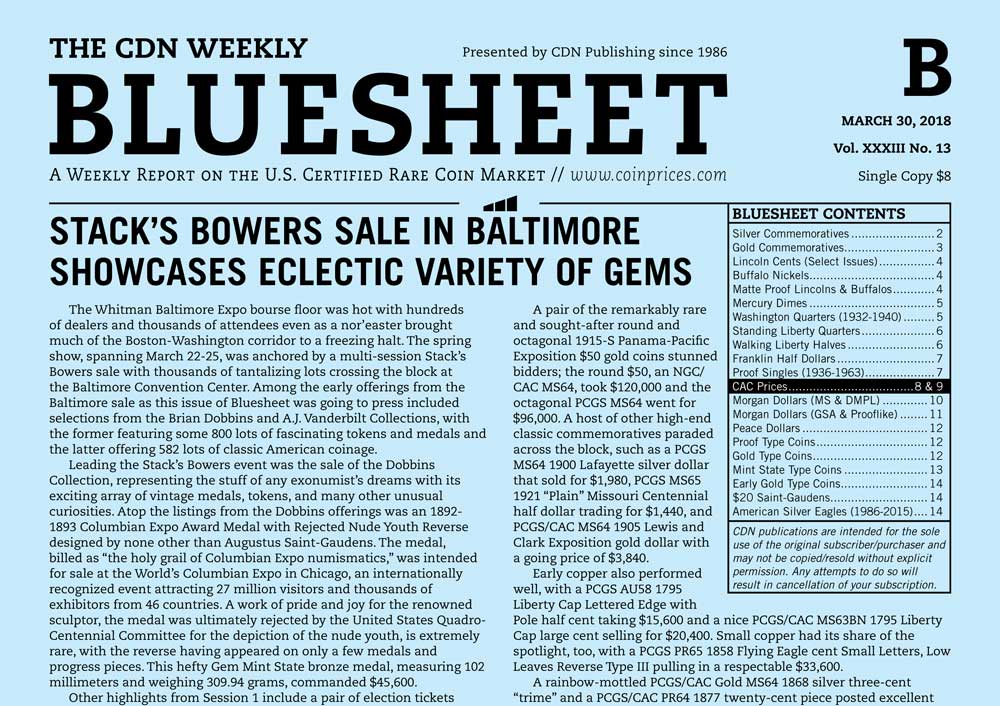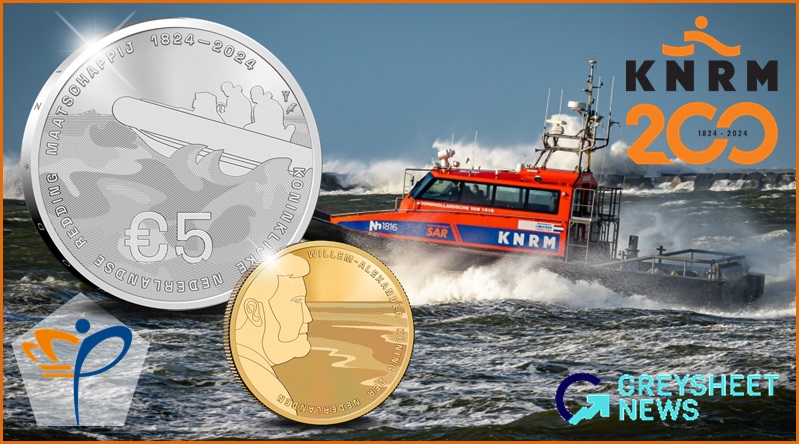STACK’S BOWERS SALE IN BALTIMORE SHOWCASES ECLECTIC VARIETY OF GEMS
The Whitman Baltimore Expo bourse floor was hot with hundreds of dealers and thousands of attendees even as a nor’easter brought much of the Boston-Washington corridor to a freezing halt.
The Whitman Baltimore Expo bourse floor was hot with hundreds of dealers and thousands of attendees even as a nor’easter brought much of the Boston-Washington corridor to a freezing halt. The spring show, spanning March 22-25, was anchored by a multi-session Stack’s Bowers sale with thousands of tantalizing lots crossing the block at the Baltimore Convention Center. Among the early offerings from the Baltimore sale as this issue of Bluesheet was going to press included selections from the Brian Dobbins and A.J. Vanderbilt Collections, with the former featuring some 800 lots of fascinating tokens and medals and the latter offering 582 lots of classic American coinage.
Leading the Stack’s Bowers event was the sale of the Dobbins Collection, representing the stuff of any exonumist’s dreams with its exciting array of vintage medals, tokens, and many other unusual curiosities. Atop the listings from the Dobbins offerings was an 1892- 1893 Columbian Expo Award Medal with Rejected Nude Youth Reverse designed by none other than Augustus Saint-Gaudens. The medal, billed as “the holy grail of Columbian Expo numismatics,” was intended for sale at the World’s Columbian Expo in Chicago, an internationally recognized event attracting 27 million visitors and thousands of exhibitors from 46 countries. A work of pride and joy for the renowned sculptor, the medal was ultimately rejected by the United States Quadro- Centennial Committee for the depiction of the nude youth, is extremely rare, with the reverse having appeared on only a few medals and progress pieces. This hefty Gem Mint State bronze medal, measuring 102 millimeters and weighing 309.94 grams, commanded $45,600.
Other highlights from Session 1 include a pair of election tickets for the 1856 election of James Buchanan and John C. Breckenridge to the presidency and vice presidency, taking $120. Another relic from presidential campaigns of the past was an NGC MS65 Abraham Lincoln “Rail Splitter” medal issued in 1860 for the 16th president’s inauguration, taking $7,800. Fans of President William Henry Harrison could have bought several items from his successful 1840 campaign, such as a group of six brass medalets that drew $216. Hobo nickels saw fervent bidding, including a piece known as “Man with Beard, Hat and Collar” hosted on an AU 1913 Type I Buffalo nickel; this piece, carved by original hobo nickel legend George Washington “Bo” Hughes, hammered for $1,800.00.
Session 2, the sale of the Vanderbilt Collection of U.S. Coins, presented a multitude of high-end certified specimens from many classic series, including a scintillating sampling of early gold issues. A PCGS/CAC MS62 1795 Capped Bust Right Heraldic Eagle Reverse half eagle traded hands for astounding $180,000, serving as the high-water mark for the second day of action. Following closely behind was a PCGS MS62 1795 Capped Bust Right Small Eagle half eagle, which sold for $132,000.
A pair of the remarkably rare and sought-after round and octagonal 1915-S Panama-Pacific Exposition $50 gold coins stunned bidders; the round $50, an NGC/ CAC MS64, took $120,000 and the octagonal PCGS MS64 went for $96,000. A host of other high-end classic commemoratives paraded across the block, such as a PCGS MS64 1900 Lafayette silver dollar that sold for $1,980, PCGS MS65 1921 “Plain” Missouri Centennial half dollar trading for $1,440, and PCGS/CAC MS64 1905 Lewis and Clark Exposition gold dollar with a going price of $3,840.
Early copper also performed well, with a PCGS AU58 1795 Liberty Cap Lettered Edge with Pole half cent taking $15,600 and a nice PCGS/CAC MS63BN 1795 Liberty Cap large cent selling for $20,400. Small copper had its share of the spotlight, too, with a PCGS PR65 1858 Flying Eagle cent Small Letters, Low Leaves Reverse Type III pulling in a respectable $33,600.
A rainbow-mottled PCGS/CAC Gold MS64 1868 silver three-cent “trime” and a PCGS/CAC PR64 1877 twenty-cent piece posted excellent results for the “odd denominations,” with final bids of $22,800 and $15,600, respectively. Speaking of obsolete denominations, a PCGS AU Details (Cleaned) 1795 Flowing Hair half dime snatched $3,360 while a PCGS/CAC Gold MS62 1846 Liberty Seated half dime, drummed up a whopping $48,000.
Other classic silver also recorded huge figures, such as an extremely rare PCGS MS63 1874-CC Liberty Seated dime with arrows going for $108,000. A PCGS/CAC AU55 1795 Flowing Hair Two Leaves half dollar took a tidy sum of $33,600, while a PCGS/CAC MS64 1904-S Barber half dollar, a series key dappled with apricot and powder blue hues, was $20,400. Another 1795-dated entry, an NGC MS62 Flowing Hair Two Leaves silver dollar, transacted for $72,000, while its same-year counterpart, a PCGS MS62 1795 Draped Bust silver dollar with off-center bust, took a final bid of $108,000. Wrapping this roundup of early Baltimore auction highlights was a particularly hot entry from the ever-popular Morgan silver dollars series, a PCGS/CAC MS61PL 1889-CC notching an astonishing $30,000.

Download the Greysheet app for access to pricing, news, events and your subscriptions.
Subscribe Now.

Subscribe to Monthly Greysheet for the industry's most respected pricing and to read more articles just like this.
Source: CDN Publishing











